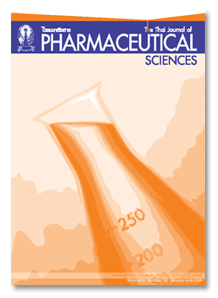ThaiScience
ThaiScience
THE THAI JOURNAL OF PHARMACEUTICAL SCIENCES
Volume 44, No. 01, Month JANUARY, Year 2020, Pages 52 - 65
Synthesis, evaluation and in silico studies of 2-mercapto-5-substituted styryl-1,3,4-oxadiazoles as potential cytotoxic agents
Anitha kumari, Shaheen Begum, Bharathi Koganti
Abstract Download PDF
Objective: The objective of the present study is to design, synthesize and evaluate 2-mercapto-5-styryl-1,3,4-oxadiazoles with an aim of developing potential cytotoxic agents and to carryout in silico studies to understand the possible interactions with the active site. Materials and Methods: The compounds were synthesized from hippuric acid. The structures of the compounds were confirmed by using spectral (FT-IR, 1H NMR and Mass) analysis. Cytotoxic potential of the title compounds was determined by using MTT assay, on MCF-7, HeLa and A549 cell lines. Results: Marked cytotoxicity was observed for 3,4,5-trimethoxy derivative 3g (IC50-17.12μM) towards MCF 7 cell lines, followed by 4-dimethyl amino derivative 3i (IC50-34.33μM), while the standard drug Cisplatin exhibited the IC50 value of 12.06 μM. Compounds 3g and 3i also showed significant cytotoxicity in HeLa cell lines. Cytotoxicity results were well correlated with in vitro antioxidant activity of the compounds. These compounds also showed good binding interactions towards Estrogen Receptor (ER), Progesterone Receptor (PR) and human epidermal growth factor receptor 2 (HER2). The compounds were also able to comply drug-likeness, passed pharmacokinetic filters and do not have affinity for P-glycoprotein. Conclusion: The present study reveals the potential cytotoxicity of 2-mercapto-5-styryl substituted 1,3,4-oxadiazoles.
Keywords
1,3,4-oxadiazoles, cytotoxicity, antioxidant activity, estrogen receptorTHE THAI JOURNAL OF PHARMACEUTICAL SCIENCES
Published by : Faculty of Pharmaceutical Sciences Chulalongkorn University
Contributions welcome at : http://www.pharm.chula.ac.th/tjps/
